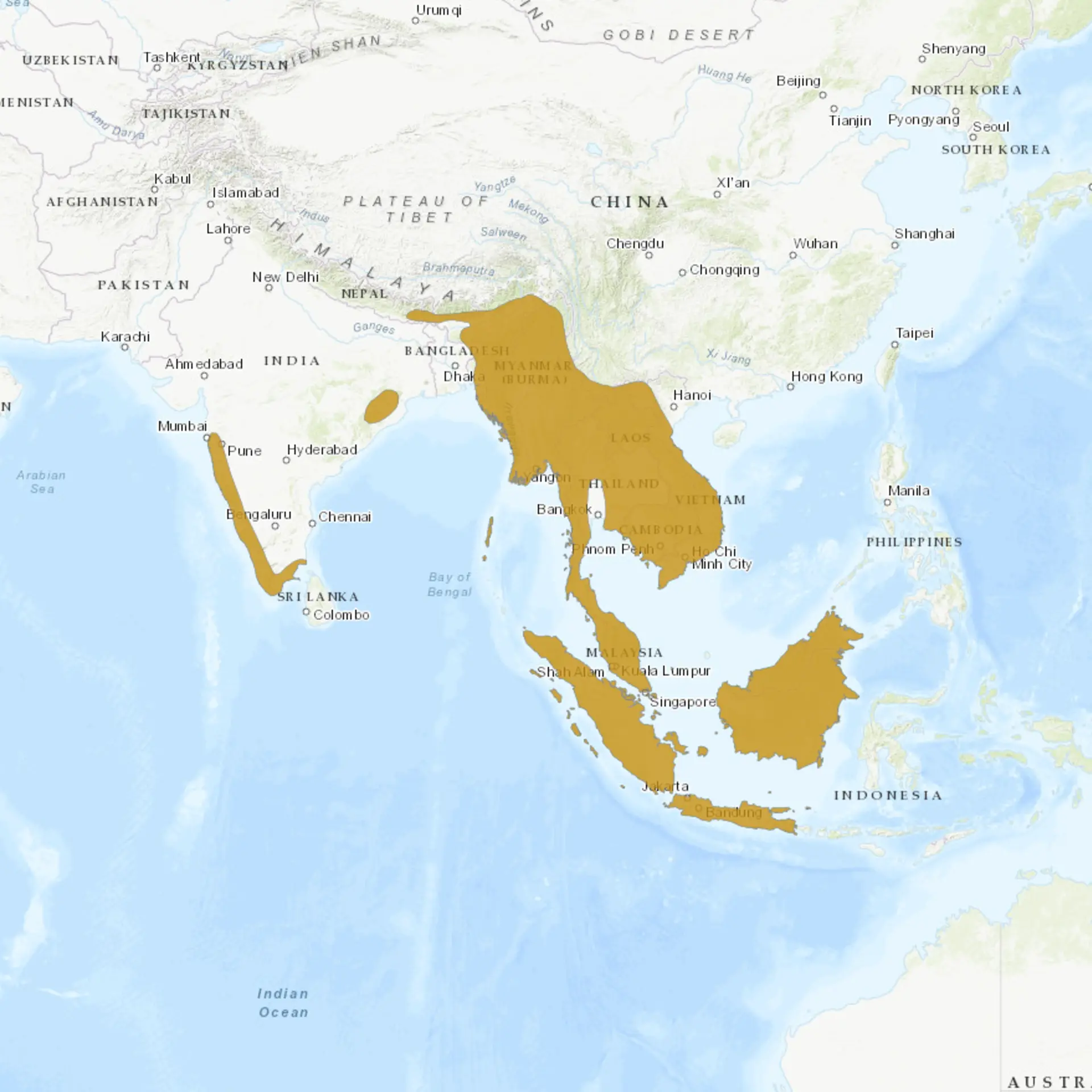Overview
The Asian Fairy-Bluebird (Irena puella) is known for its strikingly vibrant plumage, with males displaying a brilliant cobalt blue coloration contrasted against a deep velvet black. This species is found throughout Southeast Asian forests and parts of the Indian subcontinent, favoring dense tropical and subtropical forests. It is particularly noted for its fruit-dominated diet, contributing to seed dispersal within its habitat. The bird’s melodious call adds a layer of acoustic beauty to the forest environments it inhabits, making it a subject of fascination among birdwatchers and nature enthusiasts alike.
The Asian Fairy-Bluebird leads a somewhat elusive lifestyle, often seen in pairs or small groups, and is known to be quite territorial during the breeding season. Despite its vivid coloration, it can be surprisingly difficult to spot among the dense foliage where it prefers to reside. Conservation efforts are important for this species, as it faces habitat loss and degradation threats due to deforestation and land-use changes in its native regions. The bird’s presence is a strong indicator of the health of its forest ecosystem, serving as a flagship species for conservation initiatives aimed at preserving Southeast Asia’s rich biodiversity.
Efforts to study the Asian Fairy-Bluebird have provided valuable insights into its feeding habits, social structure, and reproductive behaviors, contributing to a broader understanding of the ecological dynamics of tropical forests. The beauty and ecological role of the Asian Fairy-Bluebird underscores the importance of conserving its natural habitats. Protecting these environments ensures the survival of the Asian Fairy-Bluebird and countless other species that share its habitat, highlighting the interconnectedness of forest ecosystems and their species.
Taxonomy
Kingdom
Phylum
Class
Order
Family
Genus
Species
Type
Current distribution:
The Asian Fairy-Bluebird's distribution covers a wide range across Southeast Asia, from the eastern regions of the Indian subcontinent to Southeast China, down to Indonesia, and across to the Philippines. Despite this broad range, the species is experiencing pressure from habitat loss in several areas, leading to localized declines. Protected areas and national parks are crucial in providing refuge for these birds, allowing populations to remain stable in parts of their range.
Conservation initiatives that focus on habitat preservation and restoration are essential for supporting the distribution of Asian Fairy-Bluebirds. Efforts to mitigate habitat loss and degradation and protect critical breeding and feeding sites can help ensure the species' continued presence across its natural range. Engaging local communities in conservation efforts and promoting sustainable land-use practices are key strategies for preserving bird habitats.
Physical Description:
The male Asian Fairy-Bluebird is renowned for its vivid blue and black plumage, with the upper parts, including the head, back, and tail, displaying a deep, iridescent blue, while the wings and lower parts contrast with black. Females and juveniles are less colorful, with more subdued hues of blue and green, lacking the striking contrast seen in males. This dimorphism makes the males particularly conspicuous during the breeding season when they are actively courting females.
The bird’s body is robust and medium-sized, with a strong, curved beak adapted for its fruit-based diet. The Asian Fairy-Bluebird’s wings are rounded, enabling quick, agile flight through the dense forest canopy. Despite their bright coloration, these birds can blend into the foliage, thanks to the dappled sunlight of their natural habitat, which plays off their iridescent feathers. Observing these birds in their natural setting provides a stunning visual experience as they move gracefully and agility through their arboreal environment.

Lifespan: Wild: ~8 Years || Captivity: ~15 Years

Weight: Male: 2.1–2.5 oz (60–70 g) || Female: 1.9–2.3 oz (55–65 g)

Length: Male & Female: 9.4–11 in (24–28 cm)

Wingspan: Male & Female: 14–16 in (36–41 cm)

Top Speed: 25 mph (40 km/h)
Characteristic:
Native Habitat:
The Asian Fairy-Bluebird is native to tropical and subtropical forests across Southeast Asia, including parts of India, China, Indonesia, and the Philippines. Its preferred habitats are dense, moist forests where it can find abundant fruiting trees and thick foliage for nesting. These environments provide the necessary resources for feeding, breeding, and shelter, making the conservation of these habitats critical for the species’ survival.
The bird’s habitat preferences highlight the importance of preserving large, contiguous forest areas, as fragmentation can significantly impact their ability to find food and nesting sites. Efforts to protect and restore these forest habitats are vital for maintaining the region’s biodiversity and ensuring the long-term survival of the Asian Fairy-Bluebird and countless other species that depend on these ecosystems.
Climate Zones:
Biomes:
WWF Biomes:
Biogeographical Realms:
Continents:
Diet:
Diet & Feeding Habits:
The diet of the Asian Fairy-Bluebird primarily consists of fruits, particularly figs, which comprise a large portion of their intake. They also consume various other fruits, nectar, and some insects, adapting their feeding habits to the availability of food sources in their environment. The bird’s strong beak is well-suited to its frugivorous diet, allowing it to peel and consume fruit easily.
Feeding occurs mostly in the canopy, where these birds can be seen hopping from branch to branch in search of ripe fruits. Their feeding behavior is crucial to the ecosystem, as they are important seed dispersers for many tree species. The conservation of their natural habitats is essential not only for the survival of the Asian Fairy-Bluebird but also for the maintenance of healthy forest ecosystems where these birds contribute to plant diversity and regeneration.
Mating Behavior:
Mating Description:
The Asian Fairy-Bluebird exhibits monogamous mating behavior, with pairs forming strong bonds during the breeding season. Males attract females through visual displays, showcasing their bright plumage and vocalizations, including various musical calls and songs. These behaviors not only serve to attract mates but also to establish and defend territories against rival males.
Nesting sites are typically located in dense tree foliage, where the female constructs a cup-shaped nest out of twigs and plant fibers. The nest’s secluded location helps protect the eggs and young chicks from predators. The female lays a small clutch of eggs, usually 2-3, which she incubates while the male provides food and protection for the nest. Parental care is shared, with both parents involved in feeding and caring for the chicks until they are ready to fledge and become independent.
Reproduction Season:
Birth Type:
Pregnancy Duration:
Female Name:
Male Name:
Baby Name:
Social Structure Description:
The Asian Fairy-Bluebird is typically observed in pairs or small family groups, especially during breeding when pairs nest and raise their young. Outside of the breeding season, these birds may form larger flocks, particularly when feeding on abundant fruit sources. Their social behavior includes a range of vocalizations used for communication within groups and visual displays used by males to assert dominance and attract mates.
The territorial nature of the Asian Fairy-Bluebird during the breeding season highlights the importance of suitable habitat for nesting and feeding. Conservation efforts that protect these areas help support the species’ complex social structure, ensuring that individuals can find mates, raise offspring, and interact with other members of their species.
Groups:
Conservation Status:
Population Trend:
While the Asian Fairy-Bluebird is classified as Least Concern, certain populations are experiencing declines due to ongoing threats to their habitats. Deforestation for agriculture, logging, and urban development has led to habitat fragmentation, making it increasingly difficult for these birds to find adequate food and nesting sites. Conservation efforts are focused on protecting and restoring forest habitats, ensuring the species has access to the resources it needs for survival.
Public awareness and education about the Asian Fairy-Bluebird and its ecological role are crucial for building support for conservation measures. Initiatives that involve local communities in habitat protection and restoration have shown promise in conserving the bird’s natural environments. By preserving the forests that the Asian Fairy-Bluebird calls home, conservation efforts also support the broader biodiversity of these ecosystems, benefiting countless other species.
Population Threats:
The primary threat facing the Asian Fairy-Bluebird is habitat loss due to the expansion of agricultural land, logging, and urbanization. These activities lead to the fragmentation of forests, reducing the availability of food and nesting sites for the birds. Illegal bird trade is another concern, with the species’ striking appearance making it a target for capture and sale in the pet market.
Climate change poses an additional threat, potentially altering the distribution and availability of fruit trees that the Asian Fairy-Bluebird relies on for food. Efforts to combat these threats include habitat protection and management, law enforcement to curb illegal trade, and research to understand the impacts of climate change on the species’ habitats.
Conservation Efforts:
Conservation strategies for the Asian Fairy-Bluebird focus on habitat preservation and restoration, establishing protected areas, and enforcing laws against illegal trade. Reforestation projects and managing existing forests to promote a diversity of fruiting trees can help ensure the birds’ availability of food sources. Engaging local communities in conservation actions and raising awareness about the importance of biodiversity can also enhance the effectiveness of these efforts.
Collaboration between conservation organizations, governments, and local stakeholders is key to successfully conserving the Asian Fairy Bluebird. By working together, these groups can implement comprehensive strategies that address the species’ threats and promote the long-term health of forest ecosystems.
Additional Resources:
Fun Facts
- The Asian Fairy-Bluebird’s vibrant plumage results from structural coloration, where the microscopic structure of the feathers reflects light to create the vivid blue seen in males.
- They have a sweet, melodious call that adds to the auditory landscape of their forest habitats, often described as musical and enchanting.
- This species plays a crucial role in forest ecosystems as a seed disperser, aiding in the regeneration of fruiting trees upon which many forest species rely.
- Despite their bright coloration, Asian Fairy-Bluebirds can be surprisingly difficult to spot in their natural habitat, blending into the dappled sunlight of the forest canopy.
- Conservation efforts for the Asian Fairy-Bluebird also benefit other species that share its habitat, demonstrating the interconnected nature of biodiversity conservation.
- The Asian Fairy-Bluebird is a favorite among birdwatchers and photographers, who are often captivated by its stunning appearance and melodic song.
- In some cultures, the Asian Fairy-Bluebird is associated with good luck and happiness, symbolizing the beauty and richness of the natural world.
- The species’ ability to adapt to different forest habitats has helped it maintain stable populations in parts of its range. Still, it remains dependent on conserving these environments for its long-term survival.
- Research on the Asian Fairy-Bluebird contributes to our understanding of tropical forest ecology, highlighting the importance of preserving these complex ecosystems.
- Conservation programs that focus on habitat restoration and protection offer hope for the future of the Asian Fairy-Bluebird. They emphasize the role of human stewardship in preserving the planet’s biodiversity.







